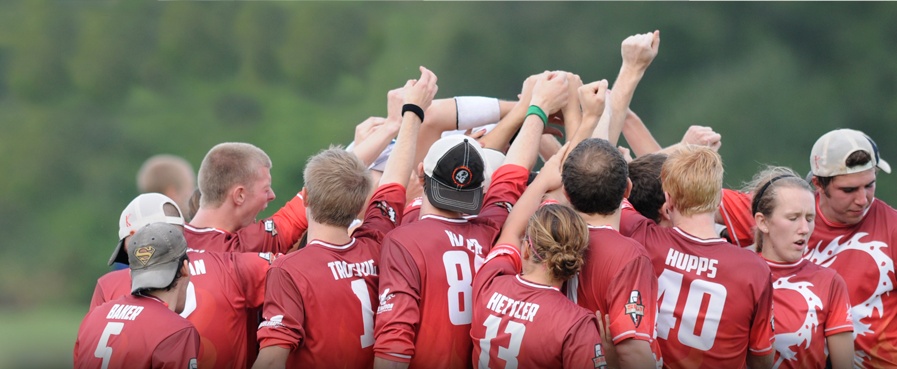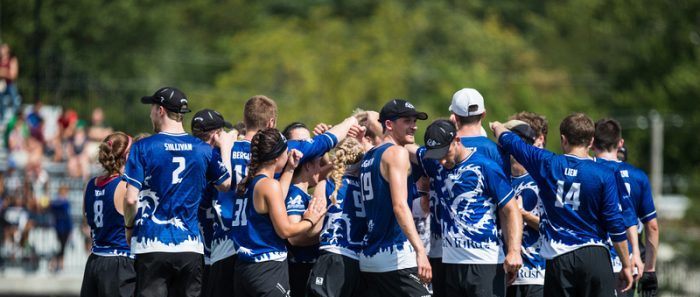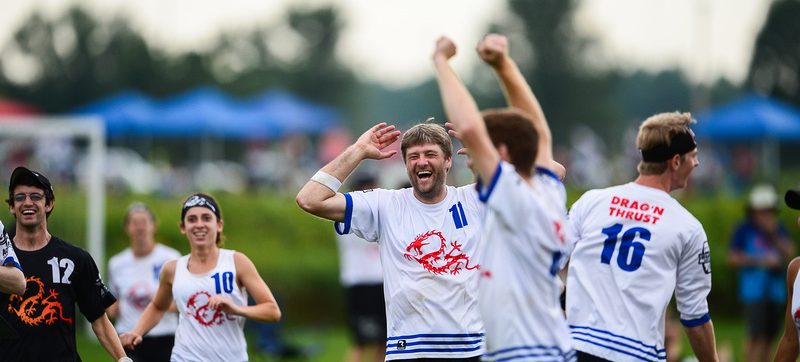By Erica Baken
You drop your bag next to your teammate, grab your cleats, and start lacing them up. You’re at your weekly Wednesday practice, nothing special, but you’re excited to get out on the field. You see some of your teammates tossing a disc, jogging, warming up.
Simply observing others throwing or running increases your heart rate, your respiration, and your lungs’ efficiency in exchanging oxygen for carbon dioxide.
While chatting, your buddy mentions a ridiculous play you made last practice, and you remember how it felt to sky the tallest player on the team. Flashes of other spectacular plays cross your mind. Remember when Hupps ran down that impossibly far huck and just barely toed the line? Remember when Jaime went from sprinting in one direction to laying out in the other in a split second? Yeah, that was cool.
Internal imagery of exercise increases heart rate and respiration even more than observing your teammates. Imagining those specific tasks (jumping, laying out, cutting) also sends neural signals to the muscles used in those tasks, making them fire microscopically in the same sequences as if you were actually doing them. Each time that task is imagined or performed, that particular neural pathway strengthens and becomes easier to stimulate.
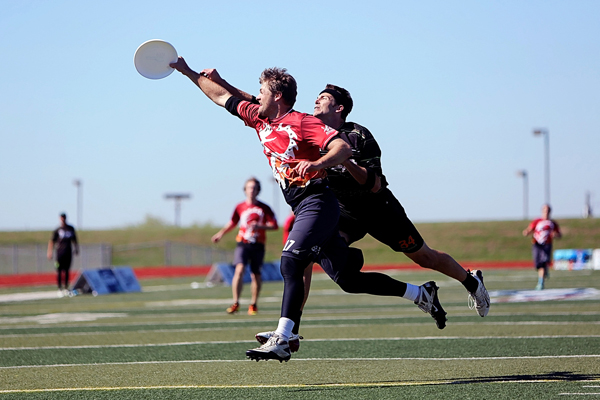
Photo by UltiPhotos.com
Through the warm-up and the beginning of practice, you’re feeling good. You aren’t tired yet, but the captains have warned you this is going to be a tough practice. You’re going to be asked to push yourself, and you will.
At the beginning of the workout, your muscles release particular hormones that let your nervous system know your muscles need blood. Your body responds by constricting blood vessels that feed the kidneys, stomach, intestines, and other organs that aren’t crucial for athletic activity. Even your brain gets a bit less blood. Your blood carries oxygen and glucose to the muscles, and rids them of carbon dioxide and other toxins.
The first few drills increase in intensity, and you start to sweat. Your team splits into smaller groups to set up the ‘Triangle of Death’ drill, and as is typical with many Ultimate drills, this includes aspects of endurance, sprinting, explosive strength, and coordination. Your body must be ready for anything.
Your muscles only move by ‘consuming’ ATP (adrenotriphosphate). When the drill calls for running around one cone to another back and forth, your muscles use a combination of aerobic respiration and the Glycogen-Lactic Acid (GLA) system, or ‘anaerobic metabolism’ to supply glucose and oxygen for ATP production for the first minute or two. After the muscles’ glycogen resources are depleted, your muscles use aerobic respiration to supply working muscles with oxygen and glucose, which produce ATP in the breakdown of glucose. This gives your muscles a chance to replenish the glycogen in preparation for more anaerobic metabolism. When a short sprint is called for, your body turns to the Phosphagen System, where a compound found in the muscle cells called creatine phosphate creates ATP very rapidly. However, all of the creatine phosphate is used up in about 9 seconds, at which point the body turns back to the other two slower mechanisms.
All three mechanisms are used in Ultimate, and a large part of getting in great shape for our sport is dependent on increasing the amount of time your muscles can last using the Phosphagen System and the GLA System as well as decreasing the length of rest period necessary to replenish those two systems. This can only be achieved by repeatedly reaching those thresholds.
The scrimmage part of practice has finally arrived! Most days, this is the best part of practice, but today, the captains are adding sprint punishments for turnovers. After every point, the whole team will do a full field sprint for each turnover.
During the drills, you have hit the threshold of both the GLA and Phosphagen systems, but only a few times. Each break in the action allows your muscles to replenish its glucose and remove the toxins. The breaks, however, do not completely reset the systems, and as your muscles fatigue, your body’s defense mechanism kicks in: pain.
[SIDENOTE: Evolution shaped all organisms to have warning bells go off (pain) when we’re putting our lives at risk. However, the warning bells we experience protect against many dangers that we no longer face. For example, if our ancient ancestors ran too hard after prey early in the day, they put themselves at risk of being too tired to run from a predator that afternoon, hence the brain telling you to stop working when there is a threat of being tired or sore later. There is a long discussion I could go into on the topic of our archaic and outdated warning bells, and why we should feel free to ignore them (to an extent), but that is not the point of this article.]
You’ve been scrimmaging for over 30 minutes, and the sprint punishments have turned from tough to grueling. You’re thinking you can only handle a few more, but as your team tires, you all make more mistakes. It is a vicious cycle.
Your brain starts telling you that you’ve spent all the energy you have, that your ‘gas tank’ is empty. Your muscles also respond to your brain’s signals, and they start to conserve energy by weakening their responses to your commands to sprint.
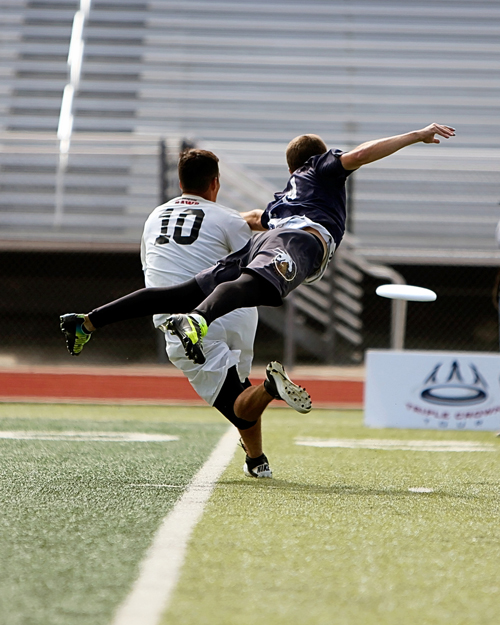
Photo by UltiPhotos.com
You and your teammates are completing these field sprints slower and slower. You feel your muscles ache, and they feel heavy and weak. Just as you’re beginning to give in to your body’s defeat, a teammate on the sidelines yells your name, triggering a memory to pop into your head. In an instant, you see yourself making that incredible layout D in the last point of the semis game two months earlier. You see the look of horror on the throwers face when he realized, just a little too late, that you were gonna get it. You remember the light ‘thunk’ your fingers made on the rim of the disc. You can hear your teammates’ screams and cheers from that day, and you can’t help but smile. Suddenly, you’re up to full speed again.
With certain imagery, you can trick your brain into releasing epinephrine (adrenaline) into the blood stream that, among many other things, increases glycolysis in muscle cells, allowing your muscles to fire quickly again. Just as with imagining the plays before practice started, your body responds similarly to actual and imagined events. Therefore, whether you watch, do, or imagine a spectacular play, your body will respond similarly (to varying degrees, of course). With your adrenal medulla releasing more epinephrine, the actual capacity and responsiveness of your muscles increases.
That burst of energy only lasted for a minute. Now, you’re light headed, and you’re on the verge of losing your lunch. You brain is yelling even louder now, “Stop! I can’t!” But your captain tells you you’ve got 2 more sprints before you’re done. You shake your head, you’re panting… and then you realize that this moment, this horrible moment, is an incredible opportunity to improve. Come Sunday of next tournament, your team may need you to get that layout D again, but if you stop pushing yourself now, you may not have it in you. It may cost your team the game, even the championship… So you start to sprint again.
Blood being diverted from your brain makes you light headed, and blood diverted from your digestive system makes the food in your stomach feel like a burden to your body, and making your body reject the food. Neither feeling means that you are causing yourself lasting harm. By continuing to use up your muscles’ stores of creatine phosphagen, oxygen, and glucose, you are only sending stronger signals to your brain that it must improve your muscles’ ability for the future. All parts of your body have gotten the signal multiple times that they need to be prepared for truly exhausting moments like this, because you will do it again.
And then it is done. You did it. Your brain told you over and over that you couldn’t, and yet, here you are, back at your bag, unlacing your cleats, and you’re still breathing. That night and the following few days your body recovers and deals with the work you put it through. It may not feel great, but you better believe your body will be far better equipped for your next tough practice. More importantly, you heard your body saying, ‘I’m done’ but refused to listen. You learned that listening to your body is important, but on the topic of exhaustion, it is often wrong. Your muscles are far stronger and can perform for far longer than your brain believes, and that realization will allow you to continuously push those limits and become a truly remarkable athlete.
So, who is ready for practice?
Post Script: I wrote this article in the light of the two most common and contradictory pieces of athletic advice I’ve ever received: ‘No pain, no gain,’ and ‘Listen to your body’s limits.’ Clearly, I follow the first piece of advice more closely, and I would urge others to do the same. In understanding part of the science behind muscle fatigue and the psychological aspect of exhaustion, and knowing that that discomfort and pain does not always portend injury, but can mean growth, I find it much easier to push myself past my point of exhaustion. I hope it does the same for others. (As a disclaimer, I know I am not the fastest or strongest player on our team. I believe, however, that I am continuously working to be my fastest and my strongest, which is all I can do.) I would also hope that the advice of ‘Listen to your body’s limits’ becomes ‘listen to your body’s injuries.’ I know that injury avoidance is very important for both the individual and team. However, many people let their fear of injury slow their athletic development. I trust that most athletes who have played any sport for more than a year can tell the difference between muscle fatigue and injury, and that discrepancy should be the deciding factor for whether it is time to rest or not. This article is not meant to promote self-harm, only to unveil part of the biology behind our exercise, and briefly explain the different stages of our workouts. I also realize that I left out many aspects of the workout, but for brevity’s sake, I edited.
